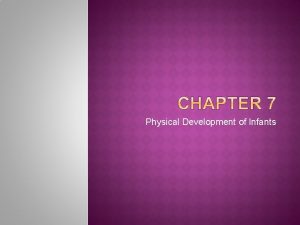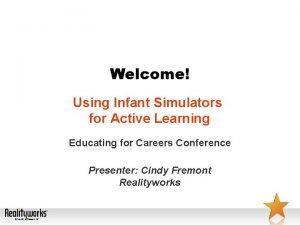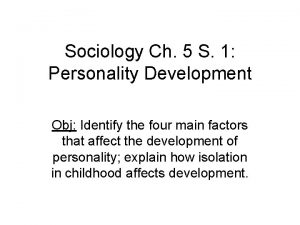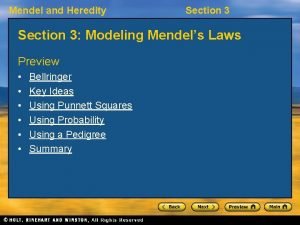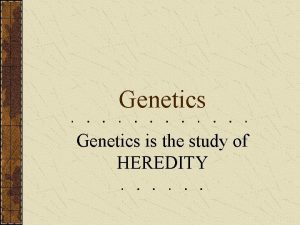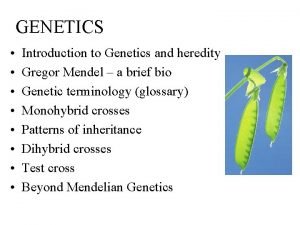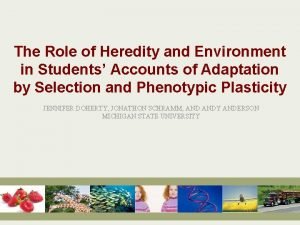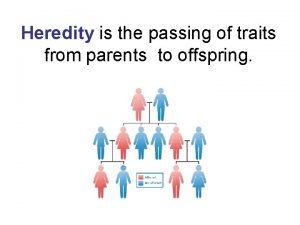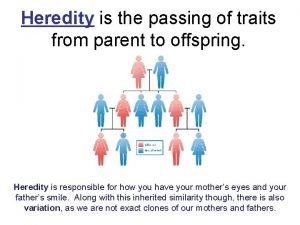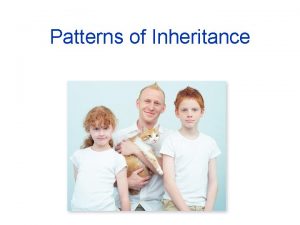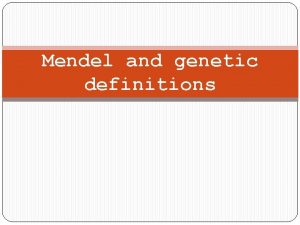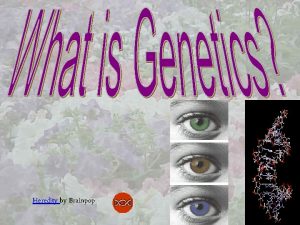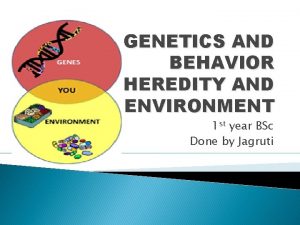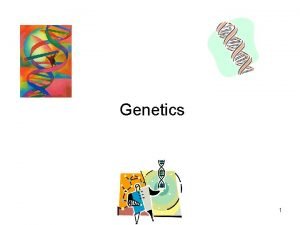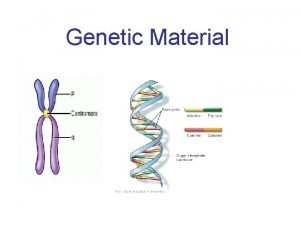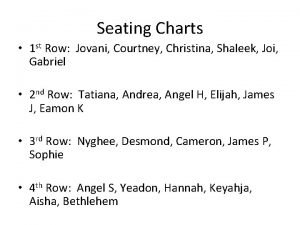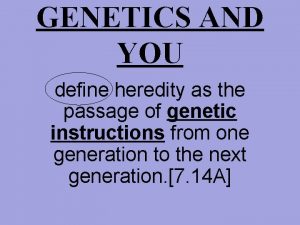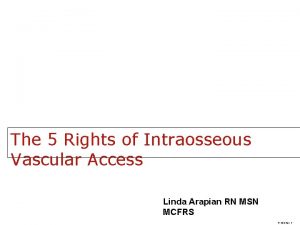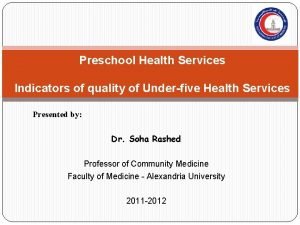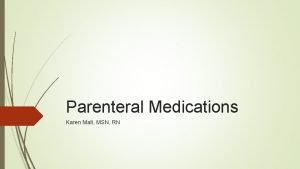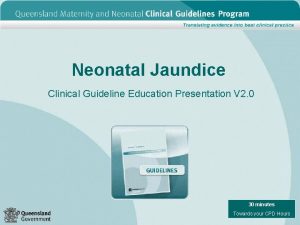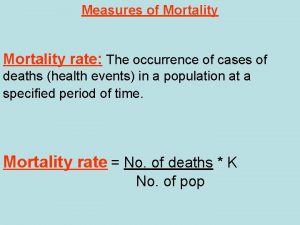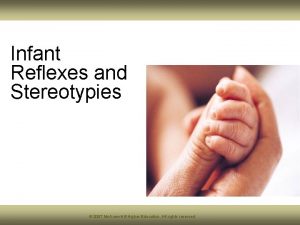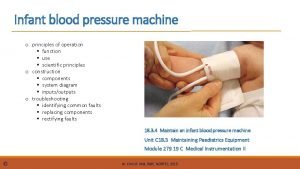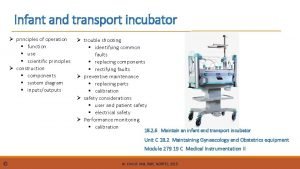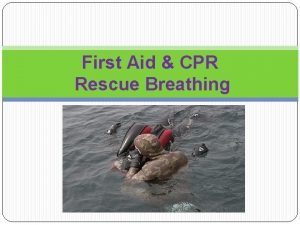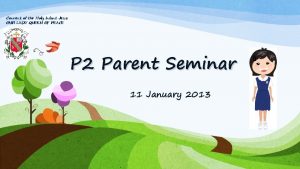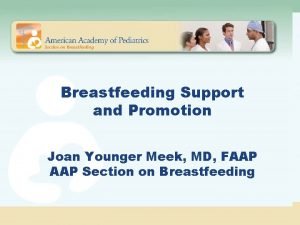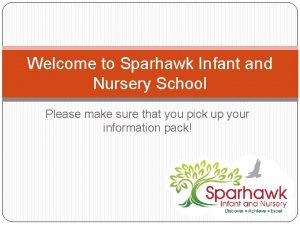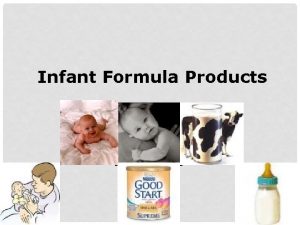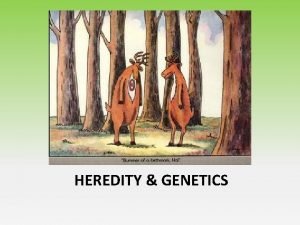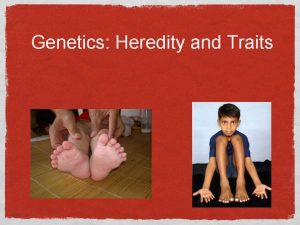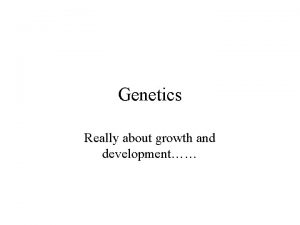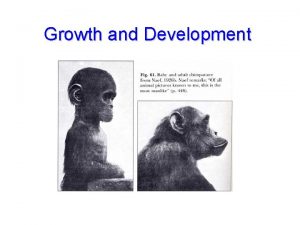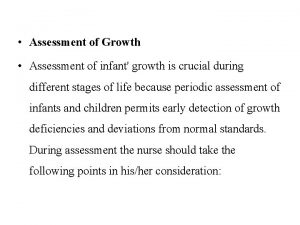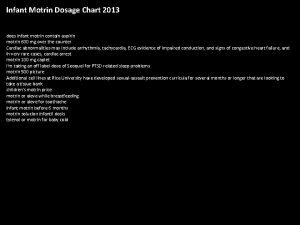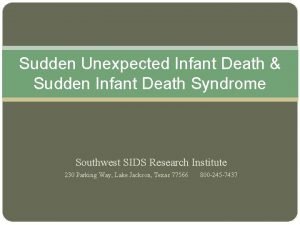Infant Development Influences on growth n Heredity n

















































































- Slides: 81

Infant Development



Influences on growth n Heredity n Nutrition n Health n environment

Each Child is Unique n Rates of growth in first year may vary – Birth length increases by 1 ½ times – Birth weight triples n Milestones are celebrated by parents and used by childcare workers n Development is an orderly process – Follows the same sequence for all children n Failure to thrive – term doctors use when growth slows considerably



Growth and development Males Females Age Length/in Weight/lbs Birth 19 3/4 7. 5 19. 5 7. 5 3 months 24 13 23. 5 12 1/4 6 months 26. 5 17. 5 25. 5 15. 5 9 months 28 20. 5 27. 5 18 ¾ 12 months 29 22. 5 29 21

Proportion n Babys head and abdomen are larger

Senses n Vision n http: //www. youtube. com/watch? v=c. CFzqcje 838

Senses continued n Hearing – Develops before birth – They respond to the tone of voice not words

Senses continued n Touch – Rely on touch of others n Smell and taste – Develops rapidly

Voice Its important to talk to your child n Newborns cry=shrill. The cry softens as lungs develop n n 3 – Month Language Developmental Checklist – – n 7 – Month Language Developmental Checklist – – – n Smiles at the sound of your voice Begins to babble Begins to imitate some sounds Turns head toward direction of sound Responds to own name Begins to respond to “no” Can tell emotions by tone of voice Responds to sound by making sounds Uses voice to express joy and displeasure Babbles chains of sounds 1 Year Language Developmental Checklist – – – Pays increasing attention to speech Responds to simple verbal commands Babbles with inflection (changes in tons) Says “dads”: and “mama” Uses exclamations, such as “Oh-oh!” Tries to imitate words

Reflexes n What is a reflex? n Sucking reflex – stimulated when something is put into babies mouth n Rooting reflex – When babies cheek is poked baby turns head towards side of face that was touched

Motor skills n Gross motor skill – Large muscles n Fine motor skill – Small muscles

n Fine or gross motor skill?

Caring for an infant n Holding a baby – Always hold newborns head n Sleep routines

Shaken baby syndrome n Causes: n Effects: n Preventative Methods:

Relax Stop Take a Break Ask for help

Sudden infant death syndrome S. I. D. S Sudden infant death syndrome (SIDS) is the unexpected, sudden death of a child under age 1 in which an autopsy does not show an explainable cause of death. The following have been linked to a baby's increased risk of SIDS: n n n Sleeping on the stomach Being around cigarette smoke while in the womb or after being born Sleeping in the same bed as their parents (co-sleeping) Soft bedding in the crib Multiple birth babies (being a twin, triplet, etc. ) Premature birth Having a brother or sister who had SIDS Mothers who smoke or use illegal drugs Being born to a teen mother Short time period between pregnancies Late or no prenatal care

Feeding an infant n Breast vs. Bottle


Caring for an infant n Introducing solid foods § weaning n Allergies § Signs to watch for n Dressing a baby n Bathing n Diapering n Healthcare – Teeth § teething

Safety poster Make a safety advertisements for parents and caregivers of infants (0 -1)in the following areas: n Home n – – n Bathroom Kitchen Bedroom Living area Outdoor – Playground/“Play houses”/sandbox n n Water Car Food Sleep

Safety concerns n Preventing – Choking – Falls – Sun – Suffocation – Poisoning – Animal – Water – Burns – clothing

Regular checkups n Immunizations – Shot of small amount of a weakened or dead disease n Watching for illness § Irritability § Lack of energy § Constipation § Nasal congestion § Coughing § diarrhea

Infant Physical development n Babys first year slideshow

Infant Social/Emotional development

Infant Social/Emotional Development n Emotional development – Emotions and crying § Colic: uncontrollable crying by an otherwise § Reflex: partially digested food rises in the throat – Self comforting

n Attachment and emotional development – Communication – Failure to thrive n Temperament

Social Development and learning n Cause and effect n Imitation n Stranger anxiety

Hand eye coordination n http: //www. howcast. com/videos/8873 - Preschool-Activities-For-Learning. Hand-Eye -Co. Ordination-Pre-K-Activities

Toddler Sleep n http: //www. youtube. com/watch? v=uh. URVYrlg 4&safety_mode=true&persist_safety_mode=1&safe=active


Nutrition n http: //www. mypyramid. gov/preschoolers/index. html n http: //www. livestrong. com/video/1719 - healthy-food-choices-snacks-toddlers/

Do now: Toilet Training Quiz Why can’t you toilet train a baby? List two signs a child is ready to toilet train? What can you do to prepare your child to toilet train? What is regression and how does it relate to toilet training? Fill in the blanks: Flushing can be _______ and ______. Nightime control comes _____ than daytime control. More _____ wash their hands than _____ do. Respect the child’s ____ and _____.

Safety n http: //www. safety 4 toddlers. com/babyproo f_tips. htm n http: //www. howcast. com/videos/458452 Toddler-Safety-With-Kim-Dulic n http: //www. safeny. gov/media/seatbro. htm

hygiene n http: //abcnews. go. com/Health/Parenting/ pressure-potty-train-earlier/story? id=12972798

Social emotional development n Temper tantrum n Phobia n Self centered n Negativism n Jealousy n Separation anxiety n empathy

As a parent how can you adjust your child’s emotional development?

Sleep n Why is it so important that a toddler is on a regular sleep cycle and gets an adequate amount of sleep? n REM versus NREM sleep – http: //www. youtube. com/watch? v=Z_d. H 2 MX _RH 0&safety_mode=true&persist_safety_mod e=1&safe=active n Infant sleep cycle is about 60 mins

n How can parents help children develop social skills?

play n Parallel – http: //www. youtube. com/watch? v=uf 3 o. HEEy kp. M&safety_mode=true&persist_safety_mode =1&safe=active – http: //www. youtube. com/watch? v=Nbsg. XKv. T GCQ&safety_mode=true&persist_safety_mod e=1&safe=active – http: //streaming. videatives. com/assets/220 n Imaginary friends

n How can parents guide behavior? n How can parents deal with aggressive behavior? – biting – Kicking – Tantrum http: //www. abc 15. com/dpp/lifestyle/family/toddlertantrums-how-to-prevent-them-from-happening http: //abcnews. go. com/Health/video/happiest-toddlerblock-9934262

n On small pieces of scrap paper write responses to the video. – Baby cousins side by side [ Go to Site ] Video clip of 6 mos and 8 mos interacting – Twin Baby Boys Laughing [ Go to Site ] 4 mos old babies laughing at each other – Baby crying in the rain [ Go to Site ] Is mom meeting baby's needs?

Emotional development n Process of learning to recogniz 3 e and express feeling to establish a personal identity Emotions and crying: n A feeling response->care->cuddle, move the baby, sing, offer a baby a toy n Uncontrollable crying: Colic: uncontrollable crying by an otherwise healthy baby Reflux: a condition in which partially digested food rises in the throat Self comforting: thumb sucking, pacifiers

Attachment and Emotional development: a baby’s bond to its caregiver n Communication: Infants respond to voice, facial expressions, eye contact n Failure to thrive: Babies do not grow and develop properly n Temperament: A persons unique personal makeup How a baby reacts to the environment *temperament traits can not be changed- parents must learn how to adapt tot the temperament n

Social development and learning: Process of learning how to interact and express oneself to others n Cause and effect: n – Relationship between events in which one event is caused by another event n Imitation/model: – Teach through example n Stranger anxiety: – Fear of unfamiliar people

1 Month n Coos and babbles n May cry a lot but will quiet down when he/she sees caregivers face

Month 2 - 3 n n n n Maintains brief eye contact while being fed Makes different crying sounds for different needs Begins to smile Eyes can show moving objects Wants companionship May like being tickled Can tell a smile from a frown

Month 4 -6 n Turns to sounds of familiar voices n Laughs , squeals , babbles n Can tell the difference between family members n Reaches out to play n May cry when left alone

Month 7 -8 n Tries to imitate sounds n Plays alone and plays longer with others n Enjoys other children n Begins to experience stranger anxiety

9 -10 months n Responds to no and own name n Says simple words like no , bye, mama , dada n Crawls around to look for parents n Enjoys playing peekaboo and sound games

Month 11 -12 n Uses gestures as well as simple body language n Shows stronger likes and dislikes n Spends time looking in mirrors

Social development through play: 0 -6 months n play games with toys or objects the baby can touch n place colorful toys or objects that the baby can learn to recognize n make noise with a rattle n Follow the babies lead or example. Laugh and smile after the baby does 6 -12 months n play peek a boo n set toys just out of reach for baby so they must crawl n read to the baby simple books n play silly songs and dance with the baby n give baby plastic buckets that they can fill up with things

n Intellectual development

Methods of learning: n Incidental learning: n Trial and error learning: n Imitation n Directed learning n http: //www. ehow. com/info_7896195_teac herdirected-activities-infants-toddlers. html

Seven areas of intellectual activity

n How can we guide a child's learning?

Speech development n What is a child has speech difficulties? n Articulation vs. stuttering


Play activities: n Toys: Evaluation – Are they safe? – Durable? – Colorful? n Books: – Does the book teach a lesson? – Is it age appropriate?

http: //www. youtube. com/watch? v=uq. Gz 7 uqo. PZ 4&feature=related


Shows neurons of a newborn with few dendrites compared to older children with more dendrites

Ways to stimulate infant brain development Keep it simples and natural n Match experiences to the Childs mental abilities n Practice makes perfect n Actively involve baby n Provide variety but avoid overload n Avoid pushing the child n

What is sensorimotor period? n Piagets first stage of learning that lasts from birth –age 2. during this period they learn mostly from their senses and their own actions Stage Approximate age Characteristics/ intellectual abilities Stage 1 Birth to 1 month practices reflexes does not understand self as a separate person Stage 2 1 -4 months Develops hand mouth coordination Stage 3 4 -8 months Acts intentionally to produce results Improves hand-eye coordination Stage 4 8 -12 months Beings to solve problems Finds partially hidden objects Imitates others

http: //www. youtube. com/watch? v=_0 EYXx 9 i. I 64&feature=related * n http: //www. youtube. com/watch? v=JOr. Ow 8 L_Gb 4&feature=related n http: //www. youtube. com/watch? v=GAAOWNx 0 e 0&safety_mode=true&persist_safety_mode=1 n http: //www. youtube. com/watch? v=FZ 3401 XVYww&feature=related&safety_mode=tr ue&persist_safety_mode=1

Object permanence n The concept that objects still exist even when they are out of sight n http: //www. youtube. com/watch? v=Nj. Bh 9 ld_y. Io &safety_mode=true&persist_safety_mode=1 n http: //www. youtube. com/watch? v=Pu. P 53 Bb. IY 0 A&safety_mode=true&persist_safety_mode=1

How can parents encourage learning? n Learn about child development n Give the child attention n provide positive feedback n Express love n Read n Talk

Intellectual development of infants and young children n http: //www. youtube. com/watch? v=7 Qb 3 D XY_7 f. U&feature=related&safety_mode=tr ue&persist_safety_mode=1 n http: //www. youtube. com/watch? v=t. Li. P 4 b. TPCA&safety_mode=true&persist_safety_ mode=1

Speech development Months Birth- 3 months 4 months-6 months 7 months-1 year Developmental milestone Watches your face when you speak Babbles Cries to express hunger anger pain or discomfort Babbling sounds more like speech with different sounds Voices excitement and displeasure Gurgles Babbling has long and short groups of sounds Uses speech to get attention Imitates different speech sounds Says one or two words

Months Intellectual Developmental milestone 1 -2 months gains information through senses makes eye contact prefers faces to objects can distinguish between familiar and unfamiliar voices 3 -4 months Can distinguish between familiar faces Makes vowel consonant combinations- ah goo Can tell a smile from a frown Alert for long r periods of time- up to 2 hours Studies objects carefully Recognizes own name recognizes basic sounds 7 -8 months Imitates the actions of others Begins to understand cause and effect Remember things that have happened Sort objects by size Solves simple problems Recognizes some words Babbling imitates speech 9 -10 months Looks for dropped objects Responds to some words and phrases- no – all gone Takes objects out of contains and puts them back in May says a few words 11 -12 months Can point to and identify objects in books Fits blocks inside one another Says mama and dada for parents Speaks some words regularly 5 -6 months

Importance of play http: //www. youtube. com/watch? v=I 5 TQ 7 c. FUQ 20&safet y_mode=true&persist_safety_mode=1 n Birth -3 monthsn n n 4 -6 months- n n 7 -9 months- n n 10 -12 months-

Infant activities Soapy water play Cheerio pickup http: //www. brighthub. com/education/early -childhood/articles/109759. aspx

Infant activities 0 -6 months 1. 2. 3. 4. 5. 6. 7. 8. Talk and sing to the babies, when you feed, diaper, and clean them. Imitate the sounds that the babies make. Point to and say the names of the babies' mouth, ears, nose, fingers, etc. Place toys and other colorful objects where babies can see and/or touch them. Shake a rattle behind a baby's head, and let the baby turn and grab the rattle. When you hold or rock the baby, sing lullabies or other soothing songs. Place babies in different positions. For example, place them on their stomach so they can practice lifting their head and rolling over. Encourage hand clasping and kicking. .

Infant activities 6 -12 months 1. 2. 3. 4. 5. 6. 7. 8. 9. 10. 11. 12. Play peek-a-boo or other games in which you disappear and reappear. Give babies a safe place where they can crawl, creep, and pull themselves up. Roll a ball or place a toy where babies have to reach or crawl for it. Give babies toys that squeak. Give babies teething toys. Read aloud books that have large pictures and not much writing. Talk to babies, and name objects as you and the babies handle them. Begin to teach what is allowed and what is not allowed. When babies indicate that they want help, provide it. Rock and hold babies when they are upset. Let babies fill containers with objects and then dump them out. Change toys often when babies get bored with them

videos n n n http: //www. youtube. com/watch? v=y. Yy. Gy. EX 0 CL 0 http: //www. youtube. com/watch? v=vm 8 Pwlgd. QE E http: //www. youtube. com/watch? v=clh 9 ENea 3 E&feature=results_main&playnext=1&li st=PLA 5 D 6 FD 4 CD 59887 B 4 http: //www. youtube. com/watch? v=Dh. GRBFZBP u. E http: //www. youtube. com/watch? v=w. Ael. F 1 g. CXO w&feature=relmfu *

Info. n http: //www. livestrong. com/article/75473 - importance-play-infant-development/ http: //www. nncc. org/Curriculum/help. inf. l earn. html http: //www. npr. org/templates/text/s. php? s. Id=19212514&m=1

Infant Toy evaluation n Groups of 3 n Evaluate each toy based on the worksheet. – How does it support their development? – Is it safe? – Would you change anything? If so why?

 Growth refers to
Growth refers to Infant personality development
Infant personality development Cone of learning
Cone of learning Infant development
Infant development Plant growth definition
Plant growth definition Pith
Pith Carothers equation
Carothers equation Primary growth and secondary growth in plants
Primary growth and secondary growth in plants Vascular ray
Vascular ray Geometric growth vs exponential growth
Geometric growth vs exponential growth Neoclassical growth theory vs. endogenous growth theory
Neoclassical growth theory vs. endogenous growth theory Organic vs inorganic growth
Organic vs inorganic growth Brainpop heredity worksheet answer key
Brainpop heredity worksheet answer key Heredity characteristics include body build
Heredity characteristics include body build Heredity concept map
Heredity concept map Section 3 mendel and heredity
Section 3 mendel and heredity Section 14-1 human heredity
Section 14-1 human heredity Heredity is best described as
Heredity is best described as Pictures of heredity
Pictures of heredity Allele
Allele Genetics
Genetics ____________ is the study of heredity.
____________ is the study of heredity. Inheritance vs heredity
Inheritance vs heredity Genetics is the study of heredity and variation
Genetics is the study of heredity and variation Chapter 11 human heredity section 11-3
Chapter 11 human heredity section 11-3 Chapter 11 complex inheritance and human heredity test
Chapter 11 complex inheritance and human heredity test Chromatids
Chromatids Role of heredity
Role of heredity Section 3 mendel and heredity
Section 3 mendel and heredity When do alleles segregate during meiosis
When do alleles segregate during meiosis What are the basic units of heredity
What are the basic units of heredity Chapter 14 human heredity
Chapter 14 human heredity Mendel 9 3 3 1
Mendel 9 3 3 1 Sanger sequencing
Sanger sequencing Section 3 mendel and heredity
Section 3 mendel and heredity Section 3 mendel and heredity
Section 3 mendel and heredity Heredity
Heredity Flower structure
Flower structure What is regeneration
What is regeneration Heredity and crime
Heredity and crime 45 chromosomes
45 chromosomes Molecular basis of heredity
Molecular basis of heredity Early ideas about heredity
Early ideas about heredity Dice and coin
Dice and coin Heredity
Heredity Unit 8 lesson 4
Unit 8 lesson 4 A gene carries the ________ for a trait. brainpop
A gene carries the ________ for a trait. brainpop The scientific study of heredity *
The scientific study of heredity * What is a pheontype
What is a pheontype Zycot
Zycot Heredity acrostic
Heredity acrostic Heredity
Heredity Flocabulary genes and heredity answer key
Flocabulary genes and heredity answer key Heredity is the passage of
Heredity is the passage of Heredity
Heredity Chapter 17 lesson 2 heredity and genetics
Chapter 17 lesson 2 heredity and genetics Hart plain infant school
Hart plain infant school Drdp preschool essential view
Drdp preschool essential view The infant industry argument
The infant industry argument Counter clockwise
Counter clockwise Keeping an infant safe and well section 7-3
Keeping an infant safe and well section 7-3 Equations
Equations Pediatric life support algorithm
Pediatric life support algorithm Vastus lateralis injection site
Vastus lateralis injection site Cries scale
Cries scale Neonatal jaundice curve
Neonatal jaundice curve Death rate formula
Death rate formula Kenmore park infant and nursery school
Kenmore park infant and nursery school Primitive reflexes chart
Primitive reflexes chart Module 45 developmental issues
Module 45 developmental issues Juan soriano la niña muerta; the dead girl; dead infant
Juan soriano la niña muerta; the dead girl; dead infant Infant reflexes chart
Infant reflexes chart Infant blood pressure
Infant blood pressure Infant incubator working principle
Infant incubator working principle Infant botulism
Infant botulism Llf meaning cpr
Llf meaning cpr Convent of holy infant jesus
Convent of holy infant jesus Promoting infant health section 7-2
Promoting infant health section 7-2 Weight gain in infant
Weight gain in infant Compression to ventilation ratio adults
Compression to ventilation ratio adults Saguaro infant care and preschool
Saguaro infant care and preschool Sparhawk infant and nursery school
Sparhawk infant and nursery school
